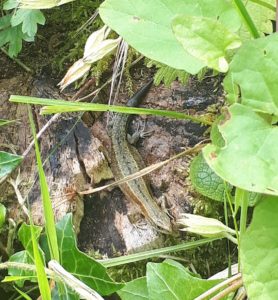Boost your wellbeing with biodiverse experiences
With our new interactive map now available for you to try, we thought we’d share some of the places that you can explore on it. Not only does time spent in nature give our mental wellbeing a boost, but the more diversity we experience the better it is for us. With time outside more treasured than ever, here are some of our top habitats to help mix up your wildlife wanders.
“The community reserves offer oases for people and wildlife” Lucy Duerdoth, Senior Warden
Summer meadows

Common lizard at Mowbray Fields
Mowbray Fields is one of our easiest places to access from Didcot, as it sits just a mile or so outside of the town centre – and its wildflower meadow is one of its specialities. Over the summer the meadow will come in to its own, with hundreds of flower heads swaying in the breeze, and the gentle buzz of hard-working insects all around. Filled with birdsfoot trefoil, yellow rattle, yarrow, knapweed, wild carrot, oxeye daisy, lady’s bedstraw, selfheal and three types of orchids, you’ll find a real mix of species here to enjoy.
And if you’ve got little wildlife spotters with you, they might see some smaller animals hidden in amongst the flowers, too – from grasshoppers and frogs, to mice and field voles – and even common lizards, though you’ll need to be quiet and quick to spot those!
Riverside walk
Wallingford Castle Meadows and Riverside Meadows sit on opposite sides of the Thames, but both offer a chance to escape, walk by the water, and take in the sights and sounds of the riverbank.
The meadows at both sites are topped with swallows and swifts swooping high above them. But if you turn towards the river, you could be in for a treat. As the hawthorn along the bank fills the air with its heady scent and swans serenely make their way down the channel, it’s possible to see water rail, kingfishers and even otters along this stretch. To see the water rails you’ll need to be there early in the day, but the local kingfishers are often out later on. Our wardens recommend listening out for their high-pitched call first – if you can tune into that, then it’s a case of looking out for their characteristic flash of blue as they fly past. In the last few years we’ve been lucky enough to have had a breeding otter on this stretch of the river, too. Although normally noctural, when females are feeding cubs they become more active in the day, as the demand for them to find food is much greater. So, keep an eye out for the tell-tale trail of bubbles in the water and you could be lucky enough to spot her in the day if she breeds again this year.
Woodland – by day and night
Little Wittenham Woods are often visited by those looking for a walk where they can lose themselves in the greenery of the trees and enjoy some dappled shade in the summer. At this time of year you’ll not only hear the red kites calling as you make your way through the woods, but you may also spot one of our regular nesting pairs – their nest site from the last five years is visible from the main path. If you’re looking for something a bit different then visiting later in the day can change the feel of the woodlands completely. As the shadows of the trees lengthen across the path and dusk starts to fall, look up and you might see bats, our only true flying mammals. Pipistrelles and Daubenton’s bats follow the treeline for both cover from predators like owls as well as to feed on insects.

Orange-tip butterfly by Jo Cartmell
Immerse yourself in wildlife
All of our green spaces support whole ecosystems, but if you want to surround yourself with bird calls, Thrupp Lake is a great place to start. Take your time as you walk round and you could be treated to the sights and sounds of our returning cuckoo, as well as swifts and swallows flying overhead. In 2017 Earth Trust volunteers installed an artificial sand martin bank, providing a place for the population here to nest – you might hear their chattery calls as they feed over the lake. For keen birders you might be able to see the breeding pair of Mediterranean gulls nesting on one of the islands in the lake – distinguishable from the black-headed gulls by their darker head (which is actually black, unlike the black gull’s which is a dark brown!). Cetti’s warbler is another one to listen out for, with its explosive song which can be heard on parts of the walk around the lake at the moment.
You might also see blue-tailed damselflies here, a species which also appears at Abbey Fishponds, another wonderful place to enjoy a few minutes of escapism. Step inside and you’ll be visiting the home of water voles, kingfishers, muntjac deer, smooth newts, frogs and toads. Chiffchaffs are often heard singing here, while orange tip butterflies flit between the scrub, and from the paths you might even spot the pink swathes of ragged robin, a wetland plant which is in flower this month.